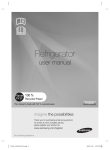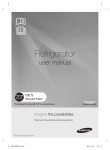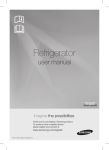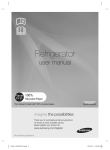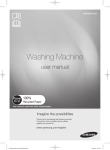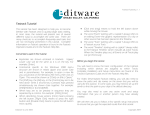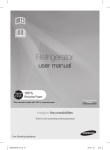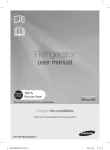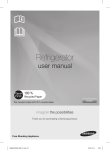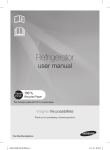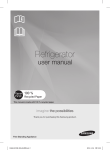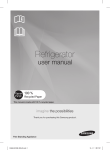Download Samsung AW2 FDR with Twin Cooling, 525 L, User Manual
Transcript
Refrigerator user manual This manual is made with 100 % recycled paper. English imagine the possibilities Thank you for purchasing a Samsung product. Free Standing Appliance DA99-03403A-12.indd 1 15. 4. 27. 2:40 Safety information SAFETY INFORMATION • Before operating the appliance, please read this manual thoroughly and retain it at a safe place near the appliance for your future reference. • Use this appliance only for its intended purpose as described in this instruction manual. This appliance is not intended for use by persons (including children) with reduced physical, sensory or mental capabilities, or lack of experience and knowledge, unless they have been given supervision or instruction concerning use of the appliance by a person responsible for their safety. • This appliance can be used by children aged from 8 years and above and persons with reduced physical, sensory or mental capabilities or lack of experience and knowledge if they have been given supervision or instruction concerning use of the appliance in a safe way and understand the hazards involved. Children shall not play with the appliance. Cleaning and user maintenance shall not be made by children without supervision. • Warnings and Important Safety Instructions in this manual do not cover all possible conditions and situations that may occur. It is your responsibility to use common sense, caution, and care when installing, maintaining, and operating your appliance. • Because these following operating instructions cover various models, the characteristics of your refrigerator may differ slightly from those described in this manual and not all warning signs may be applicable. If you have any questions or concerns, contact your nearest service center or find help and information online at www.samsung.com. Important safety symbols and precautions : WARNING CAUTION Hazards or unsafe practices that may result in severe personal injury or death. Hazards or unsafe practices that may result in minor personal injury or property damage. Do NOT attempt. Do NOT disassemble. Do NOT touch. Follow directions carefully. Unplug the power plug from the wall socket. Make sure the machine is grounded to prevent electric shock. Call the contact center for help. Note. These warning signs are here to prevent injury to you and others. Please follow them carefully. After reading this section, keep it in a safe place for future reference. CE Notice This product has been determined to be in compliance with the Low Voltage Directive(2006/95/EC), the Electromagnetic Compatibility Directive (2004/108/EC), RoHS Directive (2011/65/EU), Commission Delegated Regulation (EU) No 1060/2010 and the Eco-Design Directive(2009/125/EC) implemented by Regulation (EC) No 643/2009 of the European Union. (For products sold in European Countries only) WARNING SEVERE WARNING SIGNS FOR TRANSPORTATION AND SITE • When transporting and installing the appliance,care should be taken to ensure that no parts of the refrigerating circuit are damaged. • R-600a or R-134a is used as a refrigerant. Check the compressor label on the rear of the appliance or the rating label inside the refrigerator to see which refrigerant is used for your refrigerator. • When this product contains flammable gas (Refrigerant R-600a), - Refrigerant leaking from the pipe work could ignite or cause an eye injury. If a leak is detected, avoid any naked flames or potential sources of ignition and air the room in which the appliance is standing for several minutes. - In order to avoid the creation of a flammable gas-air mixture if a leak in the refrigerating circuit occurs, the size of the room in which the appliance may be sited depends on the amount of refrigerant used. - Never start up an appliance showing any signs of damage. If in doubt, consult your dealer. The room where the refrigerator will be sited must be 1m³ in size for every 8 g of R-600a refrigerant inside the appliance. The amount of refrigerant 2_ Safety information DA99-03403A-12.indd 2 15. 4. 27. 2:40 in your particular appliance is shown on the identification plate inside the appliance. - If the appliance contains isobutane refrigerant (R-600a), a natural gas with high environmental compatibility that is, however, also combustible. When transporting and installing the appliance, care should be taken to ensure that no parts of the refrigerating circuit are damaged. WARNING SEVERE WARNING SIGNS FOR INSTALLATION • Do not install this appliance in a humid, oily or dusty location, in a location exposed to direct sunlight and water (rain drops). - Deteriorated insulation of electrical parts may cause an electric shock or fire. • Do not place this refrigerator in direct sunlight or expose to the heat from stoves, room heaters or other appliances. • Do not plug several appliances into the same multiple power board. The refrigerator should always be plugged into its own individual electrical outlet which has a voltage rating that matched the rating plate. - This provides the best performance and also prevents overloading house wiring circuits, which could cause a fire hazard from overheated wires. If the wall socket is loose, do not insert the power plug. - There is a risk of electric shock or fire. • Do not use a cord that shows cracks or abrasion damage along its length or at either end. • Do not bend the power cord excessively or place heavy articles on it. • Do not use aerosols near the refrigerator. - Aerosols used near the refrigerator may cause an explosion or fire. • Do not install this appliance in a location where gas may leak. - This may result in an electric shock or fire. • The installation or any service of this appliance is recommended by a qualified technician or service company. - Failing to do so may result in an electric shock, fire, explosion, problems with the product, or injury. • This refrigerator must be properly installed and located in accordance with the manual before it is used. • Connect the power plug in proper position with the cord hanging down. - If you connect the power plug upside down, wire can get cut off and a cause fire or an electric shock. • Make sure that the power plug is not squashed or damaged by the back of the refrigerator. • When moving the refrigerator, be careful not to roll over or damage the power cord. - This constitutes a fire hazard. • The appliance must be positioned so that the plug is accessible after installation. • The refrigerator must be grounded. - You must ground the refrigerator to - prevent any power leakages or electric shocks caused by current leakage from the refrigerator. • Never use gas pipes, telephone lines or other potential lightening rods as ground. - Improper use of the ground plug can result in an electric shock. • If the power cord is damaged, have it replaced immediately by the manufacturer or its service agent. • The fuse on the refrigerator must be changed by a qualified technician or service company. - Failing to do so may result in an electric shock or personal injury. CAUTION CAUTION SIGNS FOR INSTALLATION • Keep ventilation opening in the appliance enclosure or mounting structure clear of obstruction. • Allow the appliance to stand for 2 hours after installation. WARNING SEVERE WARNING SIGNS FOR USING • Do not insert the power plug with wet hands. • Do not store articles on the top of the appliance. - When you open or close the door, the articles may fall and cause a personal injury and/or material damage. • Do not put items filled with water on the refrigerator. - If spilled, there is a risk of fire or electric shock. • Do not let children hang on the door. - Failure to do so may cause serious personal injury. • Do not leave the doors of the refrigerator open while the refrigerator is unattended and do not let children enter inside the refrigerator. • Do not allow babies or children go inside the drawer. - It can cause death from suffocation by entrapment or personal injury. • Do not sit on the Freezer door. - The door may be broken and cause a personal injury. Safety information _3 DA99-03403A-12.indd 3 15. 4. 27. 2:40 • To prevent children entrapment, you must reinstall the divider using provided screws after cleaning or other actions if you removed the divider from the drawer. • Never put fingers or other objects into the dispenser hole. - Failure to do so may cause personal injury or material damage. • Do not store volatile or flammable substances such as benzene, thinner, alcohol, ether or LP gas in the refrigerator. - The storage of any of such products may cause an explosion. • Do not store low temperature-sensitive pharmaceutical products, scientific materials or other low temperature-sensitive products in the refrigerator. - Products that require strict temperature controls must not be stored in the refrigerator. • Do not place or use electrical appliance inside the refrigerator, unless they are of a type recommended by the manufacturer. • Do not use a hair dryer to dry the inside of the refrigerator. Do not place a lighted candle in the refrigerator for removing bad odors. - This may result in an electric shock or fire. • Do not touch the inside walls of the freezer or products stored in the freezer with wet hands. - This may cause frostbite. • Do not use mechanical devices or any other means to accelerate the defrosting process, other than those recommended by the manufacturer. • Do not damage the refrigerant circuit. • This product is intended only for the storage of food in a domestic environment. • Bottles should be stored tightly together so that they do not fall out. • In the event of a gas leak (such as propane gas, LP gas, etc.), ventilate immediately without touching the power plug. Do not touch the appliance or power cord. - Do not use a ventilating fan. - A spark may result in an explosion or fire. • Use only the LED Lamps provided by manufacturer or service agent. • Children should be supervised to ensure that they do not play with and/or climb into the appliance. - Keep fingers out of "pinch point" areas; clearances between the doors and cabinet are necessarily small. Be careful when you open the doors when children are in the area. • Do not disassemble or repair the refrigerator by yourself. - You run a risk of causing a fire, malfunction and/ or personal injury. In case of malfunction, please contact your service agent. • If the appliance generates a strange noise, a burning or smell or smoke, unplug the power plug immediately and contact your nearest service center. - Failing to do so may result in an electric or fire hazards. • If you experience difficulty when changing the light, contact service agent. • If the products is equipped with the LED Lamp, do not disassemble the Lamp Cover and LED Lamp by yourself. - Please contact your service agent. • If any dust or water is in the refrigerator, pull out power plug and contact your Samsung Electronics service center. - There is a risk of fire. CAUTION CAUTION SIGNS FOR USING • To get best performance from the product, - Do not place foods too closely in front of the vents at the rear of the appliance as it can obstruct free air circulation in the refrigerator compartment. - Wrap the food up properly or place it in airtight containers before putting it into the refrigerator. - Do not put any newly introduced food for freezing near to already existing food. • Do not place carbonated or fizzy drinks in the freezer compartment. Do not put bottles or glass containers in the freezer. - When the contents freeze, the glass may break and cause personal injury and property damage. • Do not change or modify the functionality of the refrigerator. - Changes or modifications may result in a personal injury and/or property damage. Any changes or modifications performed by a 3rd party on this completed appliance are neither covered under Samsung warranty service, nor is Samsung responsible for safety issues and damages that result from 3rd party modifications. • Do not block air holes. - If the air holes are blocked, especially with a plastic bag, the refrigerator can be over cooled. If this cooling period lasts too long, the water filter may break and cause water leakage. - Do not put any newly introduced food for freezing near to already existing food. • Please observe maximum storage times and expiry dates of frozen goods. • Fill the water tank, ice tray, water cubes only with potable water. • Use only the ice-maker provided with the refrigerator. 4_ Safety information DA99-03403A-12.indd 4 15. 4. 27. 2:40 • The water supply to this refrigerator must only be installed/connected by a suitably qualified person and connected to a potable water supply only. • In order to operate the ice-maker properly, water pressure of 138~862 kPa (1.4~8.8 kgf/cm2) is required. • Do not spray volatile material such as insecticide onto the surface of the appliance. - As well as being harmful to humans, it may also result in an electric shock, fire or problems with the product. • Do not apply strong shock or excessive force onto the surface of glass. - Broken glass may result in a personal injury and/ or property damage. CAUTION • • • • - CAUTION SIGNS FOR CLEANING AND MAINTENANCE • Do not directly spray water inside or outside the refrigerator. There is a risk of fire or electric shock. Do not use or place any substances sensitive to temperature such as inflammable sprays, inflammable objects, dry ice, medicine, or chemicals near the refrigerator. Do not keep volatile or inflammable objects or substances (benzene, thinner, propane gas, etc.) in the refrigerator. This refrigerator is for storing food only. This may result in a fire or an explosion. Do not spray cleaning products directly on the display. Printed letters on the display may come off. Remove any foreign matter or dust from the power plug pins. But do not use a wet or damp cloth when cleaning the plug, remove any foreign material or dust from the power plug pins. Otherwise there is a risk of fire or electric shock. Never put fingers or other objects into the dispenser hole and ice chute. It may cause a personal injury or material damage. • Unplug the refrigerator before cleaning and performing maintenance. CAUTION SEVERE WARNING SIGNS FOR DISPOSAL • Ensure that none of the pipes on the back of the appliance are damaged prior to disposal. • R-600a or R-134a is used as a refrigerant. Check the compressor label on the rear of the appliance or the rating label inside the refrigerator to see which refrigerant is used for your refrigerator. When this product contains flammable gas (Refrigerant R-600a), contact your local authority in regard to safe disposal of this product. Cyclopentane is used as an insulation blowing gas. The gases in insulation material require special disposal procedure. Please contact your local authorities in regard to the environmentally safe disposal of this product. Ensure that none of the pipes on the back of the appliances are damaged prior to disposal. The pipes shall be broken in the open space. • It is hazardous for anyone other than an Authorised Service Person to service this appliance. In Queensland – the authorized Service Person MUST hold a Gas Work Authorisation or Licence for hydrocarbon refrigerants, to carry out Servicing or repairs which involve the removal of covers. (For Australia only) • When disposing of this product or other refrigerators, remove the door/door seals, door latch so that small children or animals cannot become trapped inside. Leave the shelves in place so that children may not easily climb inside. Children should be supervised to ensure that they do not play with the old appliance. • Please dispose of the packaging material for this product in an environmentally friendly manner. ADDITIONAL TIPS FOR PROPER USAGE • In the event of a power failure, call the local office of your Electricity Company and ask how long it is going to last. - Most power failures that are corrected within an hour or two will not affect your refrigerator temperatures. However, you should minimize the number of door openings while the power is off. - Should the power failure last more than 24 hours, remove all frozen food. • If keys are provided with the refrigerator, the keys should be kept out of the reach of children and not be in the vicinity of the appliance. • The appliance might not operate consistently (possibility of temperature becoming too warm in the refrigerator) when sited for an extended period of time below the cold end of the range of temperature for which the refrigerating appliance is designed. • Do not store food which spoils easily at low temperature, such as bananas, melons. • Your appliance is frost free, which means there is no need to manually defrost your appliance, as this will be carried out automatically. • Temperature rise during defrosting can comply with ISO requirements. But if you want to prevent an undue rise in the temperature of the frozen food while defrosting the appliance, please wrap the frozen food up in several layers of newspaper. Safety information _5 DA99-03403A-12.indd 5 15. 4. 27. 2:40 • Any increase in temperature of frozen food during defrosting can shorten its storage life. • Contains fluorinated greenhouse gases covered by the Kyoto Protocol. • Hermetically sealed system. • Do not vent gases into the atmosphere. • Refrigerant type: R-134a / Quantity: 0.16Kg Global Warming Potential (GWP) = 1300 • Foam blown with fluorinated greenhouse gases. Foam blown additive: Perfluorohexane Global Warming Potential (GWP) = 9,000 Saving Energy Tips - Install the appliance in a cool, dry room with adequate ventilation. Ensure that it is not exposed to direct sunlight and never put it near a direct source of heat (radiator, for example). - Never block any vents or grilles on the appliance. - Allow warm food to cool down before placing it in the appliance. - Put frozen food in the refrigerator to thaw. You can then use the low temperatures of the frozen products to cool food in the refrigerator. - Do not keep the door of the appliance open for too long when putting food in or taking food out. The shorter time for which the door is open, the less ice will form in the freezer. - Clean the rear of the refrigerator regularly. Dust increases energy consumption. - Do not set temperature colder than necessary. - Ensure sufficient air exhaust at the refrigerator base and at the back wall of the refrigerator. Do not cover air vent openings. - Allow clearance to the right, left, back and top when installing. This will help reduce power consumption and keep your energy bills lower. - For the most efficient use of energy, please keep the all inner fittings such as baskets, drawers, shelves on the position supplied by manufacturer. This appliance is intended to be used in household and similar applications such as - staff kitchen areas in shops, offices and other working environments; - farm houses and by clients in hotels, motels and other residential type environments; - bed and breakfast type environments; - catering and similar non-retail applications. 6_ Safety information DA99-03403A-12.indd 6 15. 4. 27. 2:40 Contents SETTING UP YOUR REFRIGERATOR ······························································ 7 OPERATING THE SAMSUNG REFRIGERATOR ·············································· 13 02 SETTING 01 OPERATING UP TROUBLESHOOTING ······················································································· 20 Setting up your refrigerator GETTING READY TO INSTALL THE REFRIGERATOR Model RFG23D* Depth “A” 712 mm Width “B” 908 mm Congratulations on your purchase of the Samsung Refrigerator. We hope you enjoy the state-of-art features and efficiencies that this new appliance offers. Height “C” 1740 mm Overall Height “D” 1774 mm Selecting the best location for the Refrigerator Depth “E” 774 mm • A location with easy access to the water supply. • A location without direct exposure to sunlight. • A location with level (or nearly level) flooring. • A location with enough space for the Refrigerator doors to open easily. • Allow sufficient space to the right, left, back and top for air circulation. If the Refrigerator does not have enough space, the internal cooling system may not work properly. • Please ensure that appliance can be moved freely in the event of maintenance & service. • Do not install the Refrigerator where the temperature will go below 50 ºF (10 ºC). 50 mm 125° 125° 125° 125° 1578 mm 335 mm 908 mm E C 46 mm 1089 mm B A 1103 mm 605 mm 108 mm D Each measurement based on the design dimension, so it may differ depending on the measuring method. Setting up _7 DA99-03403A-12.indd 7 15. 4. 27. 2:40 When moving your refrigerator Tools you will need (Not provided) To prevent floor damage be sure the front leveling legs are in the up position(above the floor). Refer to ‘ADJUSTING THE DOORS’ in the manual (at page 10) FLOORING For proper installation, this refrigerator must be placed on a level surface of hard material that is the same height as the rest of the flooring. This surface should be strong enough to support a fully loaded refrigerator. To protect the finish of the flooring, cut a large section of the cardboard carton and place under the refrigerator where you are working. When moving, be sure to pull the unit straight out and push back in straight. Philips screwdriver Flat-blade screwdriver Pliers Allen wrench (3/16”) (5 mm) Wrench (10 mm) Disassemble the Refrigerator doors 1. With the door opened, remove the Hinge Cover cap 1 with a Flat head screwdriver, and close the door. Remove the 3 screws holding down the Hinge Cover and remove the Hinge Cover 2 . 2 1 REMOVING THE REFRIGERATOR DOORS If the Refrigerator is too large to pass through your doorway easily, you can remove the refrigerator doors. WARNING 2. Disconnect two connectors 3 at each side of the top cap, the one connector 7 on right side door and the other connector 4 on left side door. Remove the tube 5 with pressing the dark gray color part 6 of the water line coupler. 3 Disconnect power to the refrigerator before removing the door or drawer. • Be careful not to drop, damage or scratch the door/drawer while removing them. • Be careful not to get injured while removing the door/drawer. • Reattach the door/drawer properly to avoid: - Moisture from air leakage. - Uneven door alignment. - Wasting energy due to improper door seal. 4 3 7 5 6 8_ Setting up DA99-03403A-12.indd 8 15. 4. 27. 2:40 3. Remove the 3 hex head bolts 7 attached to the upper left and right door hinges with a wrench (10 mm). With a Philips head screwdriver, remove the ground screw 8 attached to the upper left and right door hinges. Remove the upper left and right door hinges 9 . DISASSEMBLE THE FREEZER DRAWER 1. Push the upper drawer in completely. 8 2. Remove the tilting pocket 1 by pulling on both brackets 2 upward at the same time. 9 Slot 4. Lift the door straight up to remove. 02 SETTING 01 OPERATING UP 7 1 2 3. Take out the lower basket 3 by lifting the basket up from rail system. 3 5. With a Philips head screwdriver, remove the two screws 10 attached to the lower left and right door hinges. With an wrench (5 mm), remove the two hex head bolts 11 attached to the lower left and right door hinges. Remove the lower left and right door hinges 12 . 4. Remove four 10mm hex-head bolts from both sides. 12 10 11 REATTACHING THE REFRIGERATOR DOORS 5. Lift the freezer door up from the rails. To reattach the fridge doors, assemble parts in reverse order. 1. The Water Line must be fully inserted to the center of transparent coupler (Type A) or the Guide Lines (Type B) to prevent water leakage from the dispenser. Type A Type B CAUTION Putting too much food into the freezer drawers can prevent the freezer from closing completely and can cause frost build-up. Dispenser Center of Transparent coupler The Guide Lines Setting up _9 DA99-03403A-12.indd 9 15. 4. 27. 2:40 ASSEMBLE THE FREEZER DRAWER MAKING MINOR ADJUSTMENTS BETWEEN DOORS To reattach the freezer drawer, assemble parts in reverse order. Remember a level Refrigerator is necessary for getting the doors perfectly even. If you need help, review the previous section on leveling the Refrigerator. ADJUSTING THE DOORS Now that the doors are back on the Refrigerator, you want to make sure the Refrigerator is level so that you can make final adjustments. If the Refrigerator is not level, it will not be possible to get the doors perfectly even. Insert a flat-blade screwdriver (-) into a notch on the left control lever, and turn it count clockwise to level the refrigerator. (You turn the lever clockwise to lower the refrigerator and counterclockwise to raise it.) When the left door is lower than the right door. When the left door is higher than the right door. Adjustment part Adjustment part 1. If you open the drawer 1 , you can see the lower hinge 2 . 2. Insert a philips screwdriver (+) 3 into the shaft 4 of the lower hinge. 3. Adjust the height by turning a philips screwdriver (+) 3 clockwise ( ) or ). counterclockwise ( 2 flat-blade screwdriver(-) CAUTION Control Lever 4 1 Both control levers must be touching the floor to avoid possible personal injury or property damage because of tipping. If the right side is lower, perform the same procedure, but with the right control lever. 3 When you turn a philips screwdriver (+) counterclockwise ( ), the door will move up. ADJUSTING THE FREEZER DRAWER LEVEL Adjustment part Freezer Drawer 10_ Setting up DA99-03403A-12.indd 10 15. 4. 27. 2:40 1. Locate the height-adjuster 1 in the freezer drawer. Unscrew the four Phillips screws 2 slightly to loosen the door. 2 Water line installation kits are available at extra cost from your dealer. We recommend using a water supply kit that contains copper tubing. 2. Loosen the controller screw screwdriver. 3 with a Phillips The new hose-sets supplied with the appliance are to be used and that old hose-sets should not be reused. 02 SETTING 01 OPERATING UP 1 water pressure of 138~862 kPa is required. Under normal conditions, a 170 cc (5.75 oz.) cup can be filled in 10 seconds. If the Refrigerator is installed in an area with low water pressure (below 138 KPa), you can install a booster pump to compensate for the low pressure. Make sure the water storage tank inside the Refrigerator is properly filled. To do this, press the water dispenser lever until the water runs from the water outlet. Check the accessory list below. 3 3. Find the best level to align the door slope. Water filter Compression fitting Compression nut Connecting to the water supply line Example) The slope is about 2 mm (0.08 inch) as shown below. 1. First, shut off the main water supply line and turn the ice-maker off. 2. Locate the nearest cold water drinking line. 3. After connecting the water supply with water filter, turn on water supply and Flush 3L through filter before use (flush approximately 6 minutes). Slope 1 Cold water line 2 Pipe clamp Reference plane 3 Water line installation kit - Rotate the Height Adjuster to -2.0 to reduce the door slope. After adjustment, first tighten screw then screw 2 . 3 and 4 Shut off valve CHECKING THE WATER LINE A water dispenser is one of the helpful features on your new Samsung Refrigerator. To help promote better health, the Samsung water filter removes unwanted particles from your water. However, it does not sterilize or destroy microorganisms. You may need to purchase a water purifying system to do that. In order for the ice-maker to operate properly, a INSTALLING THE WATER LINE Connecting the water line to the Refrigerator. There are several items that you need to purchase to complete this connection. You may find these items sold as a kit at your local hardware store. Setting up _11 DA99-03403A-12.indd 11 15. 4. 27. 2:40 • 6.35 mm compression nut • copper tubing • plastic tubing • ferrule Refrigerator 1 Compression nut (6.35 mm) (Supplied) Plastic tubing (Supplied) 2 Compression fitting (Supplied) 3 Bulb Ferrule (Not supplied) Compression nut (6.35 mm) (Not supplied) Sticker (month indicator) Copper tubing or Plastic tubing (Not supplied) (Not supplied) Household water line 1. Slip the compression nut through the supplied plastic tubing . 2. Tighten the compression nut onto the 6.35 mm compression fitting. - If you are using copper tubing, slip the compression nut (not included) and ferrule (not included) on copper tubing (not included) as shown. - If you are using plastic tubing , insert the molded end(Bulb) of the plastic tubing into the compression fitting. Do not use without the molded end(Bulb) of the plastic tubing . 3. Tighten the compression nut onto the compression fitting. Do not over-tighten the compression nut . 4. Turn water on and check for any leakage. Only connect the water line to a drinkable water source. If you have to repair or disassemble the water line, cut off 6.35 mm of the plastic tubing to make sure you get a snug, leakfree connection. 4. Remove the filter cap and insert the filter into the filter housing. 5. Slowly turn the water filter 90º clockwise to align with the printing mark on the cover, locking the filter in position. Make sure to align the water filter label mark with center of cover filter printing as illustrated. Remember, do not overtighten. Cover filter 4 Separation of red cap. 5 Turn until the label is aligned. You should remove the right side upper glass shelf before installing the water filter. Installing the water filter. Removing any residual matter inside the water supply line after installing the water filter. 1. Remove the water filter cover 1 . 2. Remove the fixed cap by turning it counter clockwise. Keep the cap in a safe place for later use if you don’t use the filter. 3. Remove the water filter from the box and put a replacement indicator sticker on the filter as shown. Place the sticker on the filter that dates six months in the future. For example, if you install the water filter in March, put the “SEP” sticker on the filter to remind you to replace it in September. That way you’ll know when it is time to replace the filter. Normally, a filter life is about 6 months. 1. Turn ON the main water supply & turn OFF the valve to the water supply line. 2. Run water through the dispenser until the water runs clear (approx. 6-7 minutes). This will clean the water supply system and remove air from the lines. 3. Additional flushing may be required in some households. 4. Open the Refrigerator door and make sure there are no water leaks coming from the water filter. Be sure to flush the dispenser thoroughly or water may leak from it. This is due to the fact that there is still air in the line. 12_ Setting up DA99-03403A-12.indd 12 15. 4. 27. 2:40 Operating the SAMSUNG refrigerator 3 1 4 2 5 3 6 Alarm / Reset Filter (3 sec) Button The filter Indicator will be Blue when you initially insert the water filter. The filter Indicator will be Light Pink when you have used your water filter for 5 months. The filter Indicator ( ) will be Red when you have used your water filter for 6 months. 02 OPERATING USING THE CONTROL PANEL 4 7 1 Energy Saver Button 2 Freezer / Power Freeze (3 sec) Button 3 Alarm / Reset Filter (3 sec) Button 8 For better energy efficiency, press the ). Energy Saver button ( If condensation occurs on the doors, turn the Energy Saver function off. Press the Freezer / Power Freeze (3 sec) button ( ) to set the Freezer to your desired temperature. You can set the temperature between -14 ºC and -22 ºC. Press and hold the Freezer / Power Freeze (3 sec) button for 3 seconds, to speed up the time needed to freeze products in the Freezer. It can be helpful if you need to quickly freeze easily spoiled items or if the temperature in the Freezer has warmed dramatically (For example, if the door was left open). When you use this function the energy consumption of the refrigerator will increase. Remember to turn it off when you don’t need it and return the freezer to your original temperature setting. When you have enough ice, just press and hold the button for 3 seconds again to cancel the Power Freeze mode. Power Freeze mode must be activated before putting large stuff in freezer compartment at least 20 hours before. Press the Alarm button ( ) to turn off the door open alarm. After removing the old water filter and installing a new one, reset the Indicator by pressing and holing the “Alarm” button for 3 seconds. The indicator will light again in about 6months to let you know it is Time to change your water filter. Lighting Button 5 Fridge / Power Cool (3 sec) Button 6 Ice Off / Child Lock (3 sec) 7 Ice Button 8 Water Button Press the Lighting button ( ) to turn on the dispenser LED lamp. Press the Fridge / Power Cool (3 sec) button ( ) to set the fridge to your desired temperature. You can set the temperature between 1 ºC and 7 ºC. Press and hold the Fridge / Power Cool (3 sec) button for 3 seconds, to speed up the time needed to cool products in the Refrigerator. It can be helpful if you need to quickly cool easily spoiled items or if the temperature in the fridge has warmed dramatically (For example, if the door was left open). Press and hold the button for 3 seconds again to cancel the Power Cool mode. Press the Ice Off button ( ) to turn the ice making function off. If you press and hold the Ice Off button for 3 seconds, the display and dispenser will be locked. Press the Ice button to select your desired ice type. Cubed and crushed ice modes will be alternatively changed whenever you press the button. After selecting, push the dispenser Lever gently with your glass. This mode can not be used with the Water mode simultaneously. Press the Water button to dispense water. There is no Off mode additionally. After selecting, push the dispenser Lever gently with your glass. This button can not be used with the Ice button simultaneously. Water mode will be off if you press the Ice button. Some functions are activated after a fewsecond delay when the buttons are pressed, while others operate immediately. This is normal operation. Operating _13 DA99-03403A-12.indd 13 15. 4. 27. 2:40 USING THE CONTROL PANEL USING THE COLD WATER DISPENSER Basic temperature of Freezer and Refrigerator Compartments Press the Ice / Water button to select the type of you want. The basic temperature and/or recommended temperature of Freezer and Refrigerator Compartments are -19 °C and 3 °C respectively. If the temperature of Freezer and Refrigerator Compartments are too high or low, adjust the temperature manually. Controlling the Freezer temperature The Freezer temperature can be set between -14 ºC and -22 ºC to suit your particular needs. Press the Freezer button repeatedly until the desired temperature is shown in the temperature display. Keep in mind that foods like ice cream may melt at -15 ºC. The temperature display will move sequentially from -22 ºC to -14 ºC. When the display reaches -14 ºC, it will begin again at -22 ºC. Controlling the Refrigerator temperature The Refrigerator temperature can be set between 7ºC and 1ºC to suit your particular needs. Press the Fridge button repeatedly until the desired temperature is shown in the temperature display. The temperature control process for the Fridge works just like the Freezer process. Press the Fridge button to set your desired temperature. After a few seconds, the Fridge will begin adjusting towards the newly set temperature. This will be reflected in the digital display. - - - - The temperature of the Freezer, Refrigerator or pantry room may rise when you open the doors too frequently, or if a large amount of warm or hot food is placed inside. This may cause the digital display to blink. Once the Freezer and Refrigerator temperature return to their normal set temperatures, the blinking will stop. If the blinking continues, you may need to “reset” the Refrigerator. Try unplugging the appliance, wait for around 10 minutes and then plug the power cord back in. The temperature of the pantry room may be a little different according to the location inside. If communication between display and Main Controller errors, Pantry display light may blink. Once the pantry room return to their normal set temperatures, the blinking will stop. If the blinking continues for a long period of time, please contact to Samsung Electronics Service Center. No ICE Select this if you want to turn ice-maker off. • Place a glass underneath the ice dispenser and push gently against the dispenser lever with your glass. Make sure the glass is in line with the dispenser to prevent the ice from bouncing out. • Please wait 2 seconds before removing the glass under the dispenser to prevent spills. If the Refrigerator door opens, the dispenser does not work. • When Cubed Ice is selected after using the Crushed Ice feature, a small amount of residual crushed ice might be produced. • Water Dispenser Installation After installation, press the dispenser arm for at least 2 minutes to remove trapped air from the water line and to fill the water system. PUSH • In case ice doesn’t come out, pull out the ice bucket and press test button located on the right side of ice-maker. • Do not press the test button continuously when the tray is filled with ice or water as illustration. Water may overflow or ice jamming may occur. • Normal Use To fill ice bucket to maximum capacity after installation, make sure to do the following steps. 1. Allow your refrigerator to operate and cool down for 24 hours (or 1 full day). 2. Waiting 24 hours will allow your ice maker to cool properly. 3. Dispense 4 to 6 ice cubes into the glass. 4. After 8 and 16 hours, dispense a full glass of ice at each time. 14_ Operating DA99-03403A-12.indd 14 15. 4. 27. 2:40 Using the ice off function Test button Check the water level Whenever all ice is used at one time, the above step 3 and 4 must be repeated (before dispense the first 4 to 6 ice cubes, it needs waiting 8 hours). This will replenish the ice cubes and ensure maximum ice production. When you dump the ice from the ice bucket, you should press the dispenser lever once with ‘ICE CUBED’ or ‘CRUSHED’ function ON to get new ice faster after replacing the ice bucket in the refrigerator. If you have a long vacation or business trip, close the water valve and shut off the water supply to the Refrigerator. This will help prevent accidental leakages. Do not disassemble the Ice-maker personally. It may cause disorder. Do not wash or spray the ice bucket with water. Just wipe it with a dry cloth. In order to operate the ice-maker properly, water pressure of 138~862 kPa is required. 02 OPERATING 2 When selecting the Ice Off mode, remove all ice cubes from the bucket. If you are not using Push Pull on the ice dispenser, the ice cubes may clump together. Pull the lock lever forward to throw away ice cubes or remove clumped ice from the bucket. Push the bucket back until you hear a click. Water clouding phenomenon Using the water dispenser Place a glass underneath the water outlet and push gently against the water dispenser lever with your glass. Make sure the glass is in line with the dispenser to prevent the water from splashing out. If you have just installed the refrigerator or installed a new water filter,Flush 3L through filter before use (flush approximately 6 minutes). Make sure that water flows clearly again before drinking. When you do not use the water dispenser for 2~3 days (especially during the summer), the dispensed water may have a funny smell or taste. If this occurs, we recommend that you discard the first 1~2 glasses for better tasting water. All water provided to refrigerators flows through the core filter which is an alkaline water filter. In this process, the pressure in the water that has flowed out of the filter gets increased, and oxygen and nitrogen become saturated. When this water flows out in the air, the pressure plummets and the oxygen and nitrogen get supersaturated so that they turn into gas bubbles. The water could look misty due to these oxygen bubbles.The water may look temporarily cloudy due to these oxygen bubbles. After a few seconds, the water will look clear. Please wait 1 second before removing the cup after dispensing water to prevent spills. Do not pull out the lever dispenser after taking out ice or water. It comes back automatically. Ice is made in cubes. When you select “Crushed”, the ice-maker grinds the ice cubes into crushed ice. Operating _15 DA99-03403A-12.indd 15 15. 4. 27. 2:40 PARTS AND FEATURES USING THE COOL SELECT PANTRY™ Use this page to become more familiar with the parts and features of the Refrigerator. The Cool Select Pantry™ is a full-width drawer with adjustable temperature control. This pantry can be used for large party trays, deli items, pizza, beverages or miscellaneous items. There is a temperature control which can adjust the amount of cold air allowed into the pantry. The control is located on the right side of the pantry. • Press the Temp button repeatedly until your desired mode is lit. The Fresh mode (3 °C), Chilled mode (0 °C) and Deli mode (5 °C) will be selected whenever you press the Temp button. Initially, the Fresh mode is set. Though the setting temperature is different from the current temperature, the temperature will be changed to the setting temperature automatically. Water Filter Door Closer Light ( 1 ) ( 8 ) ( 2 ) ( 3 ) ( 6 ) ( 7 ) ( 9 ) ( 4 ) ( 5 ) ( 10 ) Light ( 11 ) ( 12 ) Temp You can select your Pantry temperature from among Deli (5 °C [41 °F] ), Fresh (3 °C [38 °F] ) and Chilled (0 °C [34 °F] ) modes. ( 13 ) Selection Button (1) (2) (3) (4) (5) (6) (7) (8) (9) ( 10 ) ( 11 ) ( 12 ) ( 13 ) Ice-Maker Foldable-Shelf Slide-Shelf Vertical Hinged Section Vegetable & Fruit Drawers Slide-Shelf 2 Step Foldable Shelf Dairy Compartment Door Bins Cool Select Pantry™ 1. When “Deli” is selected, the temperature of the pantry will be kept around 5 °C (41 °F). This feature helps keep food fresh for a long time. 2. When “Fresh” is selected, the temperature of the pantry will be kept around 3°C (38 °F). This feature helps keep food fresh for a longer time. 3. When “Chilled” is selected, the temperature of the pantry will be kept around 1 °C (34 °F). This feature also helps keep meat or fish fresh for a longer time. Tilting Pocket Auto Pull Out Drawer Freezer Drawer Bin 16_ Operating DA99-03403A-12.indd 16 15. 4. 27. 2:40 Deli • pineapple • lemon • avocado • potato Fresh • cucumbers • apples • oranges • grapes • zucchinis • corn Zero Zone 2. Tempered Glass shelves • steaks • hard cheeses • cold cuts • bacon • hot dogs direction shown 1 and lift it up vertically Pull the shelf out. 2 . To relocate - Tilt the front of the shelf up and guide the shelf hooks into the slots at a desired height. Then lower the front of the shelf so that the hooks can drop into the slots. CAUTION The Tempered Glass shelves are heavy. Use special care when removing them. 02 OPERATING Fruits and vegetables may be damaged under the “Zero Zone” setting. Do not store lettuce or other leafy produce in this pantry. Do not store glass bottles in this pantry. If they are frozen, they can break and CAUTION cause personal injury. To remove - Tilt up the front of the shelf in the 1 2 REMOVING THE REFRIGERATOR ACCESSORIES 1. Door Bins & Dairy Compartment To remove - Simply lift the bin up and pull straight out. To relocate - Slide it in above the desired location and push down until it stops. Injury may occur if the door bins are not firmly assembled. Do not allow children to play with bins. Sharp corners of the bins may cause injury. CAUTION Do not adjust a bin full of foods. 3. Vegetable & Fruit Drawers To remove - Pull the drawer out to full extension. Tilt up the front of the drawer and pull straight out. To relocate - Insert the drawer into the frame rails and push back into place. The drawers need to be removed before the glass shelf above them can be lifted out. Do not open the drawers while the pantry is open. It may cause a scratch or breakage to the drawer covers. Dust removal method - Remove the guard and wash in water. Operating _17 DA99-03403A-12.indd 17 15. 4. 27. 2:40 4. Cool Select Pantry™ To remove the pantry - Pull the pantry out to full extension. Tilt up the front side of pantry and pull straight out. To relocate the pantry - Push the rails to the back of the Refrigerator. Place the drawer onto the rails and slide the pantry back until it is in place. REMOVING THE FREEZER ACCESSORIES 1. Tilting Pocket To remove - Pull the brackets upward until you hear a clicking sound and remove the pocket To replace - Hook the ends of the pocket into both brackets 1 and push down until it locks into place. 1 2. Auto Pull out Drawer To remove the divider - Pull the pantry completely out to full extension and raise the front side of the divider to unhook it from the rear wall of the pantry, then lift the divider out. To relocate the divider - Hook the back of the divider over the rear wall of the pantry and push the divider down. To remove - Pull the drawer out to full extension. Tilt up rear of drawer and lift straight out. To relocate - Place the drawer onto the rails by tilting it up. Lower the drawer into place until it is horizontal and slide the drawer in. 2 USING THE DOORS The Refrigerator doors ensure that the doors close all the way and are securely sealed. When the Refrigerator door is only partially open, it will automatically close. The door will stay open when opened more than 76 mm. USING THE TILTING POCKET 1 3. Freezer Drawer To remove the freezer drawer - Pull the freezer drawer out fully. Tilt up the rear of the bin and lift it out to remove. To relocate the freezer drawer - Place the bin into the rail assembly. The Tilting Pocket can be used to store up to a 406 mm pizza if you place it as shown in the illustration. CAUTION You can scratch the side of the bin if you twist it left or right when disassembling or re-assembling it. Do not allow babies or children go inside the freezer drawer. They could damage the refrigerator and seriously injure themselves. Do not sit on the freezer door. The door may break. Do not allow children to climb into the freezer drawer. CAUTION Do not remove the divider. WARNING 18_ Operating DA99-03403A-12.indd 18 15. 4. 27. 2:40 WARNING If trapped inside, children may become injury and suffocate to death. CHANGING THE WATER FILTER To reduce risk of water damage to your property DO NOT use generic brands of water filters in your SAMSUNG Refrigerator. USE ONLY SAMSUNG BRAND WATER FILTERS. SAMSUNG will not be legally responsible for any damage, including, but not limited to property damage caused by water leakage from use of a generic water filter. SAMSUNG Refrigerators are designed to work ONLY WITH SAMSUNG WATER Filter. CAUTION Do not use benzene, thinner, or Clorox, Chloride for cleaning. They may damage the surface of the appliance and may cause a fire. Do not spray the refrigerator with water while it is plugged in, as it may cause an electric shock. Do not clean the refrigerator with benzene, thinner or car detergent for risk of fire. 02 OPERATING CLEANING THE REFRIGERATOR The “Filter Indicator” light lets you know when it is time to change your water filter cartridge. To give you preparation time to get a new filter, the red light will come on just before the capacity of the current filter runs out. Changing the filter on time provides you with the freshest, cleanest water from your fridge. WARNING CHANGING THE INTERIOR LIGHTS Do not disassemble or replace the LED type Lighting. To change the LED Type Lighting contact Samsung service center or your authorized Samsung dealer. CAUTION If Users randomly exchange the LED lamp by yourself, this may result in an electric shock or personal injury. 1. Take a new water filter and put a month indicator sticker on the filter as shown. The date on the sticker must be six months from the current date. For example, if you are replacing the water filter in March, put the “SEP” (September) sticker on the filter to remind you to replace in September. Normal filter life is about every 6 months. 2. Remove the new filter’s protective cap and remove the old filter. 3. Position and insert the new filter into the filter housing. Slowly turn the water filter clockwise to align with the printing mark on the cover, locking the filter in position. Make sure to align the water filter label mark with the center of cover filter printing as illustrated. Remember, do not over-tighten. 4. Once you have completed this process, press and hold the Alarm button for 3 seconds to reset the filter schedule. 5. Lastly, Flush 3L through filter before use (flush approximately 6 minutes) Make sure that water flows clearly again before drinking. Be sure to flush the dispenser thoroughly otherwise water may drip from the dispenser. This means that there is still air in the line. Do NOT use the water or ice dispenser without a water filter cartridge because the water line may become blocked. Operating _19 DA99-03403A-12.indd 19 15. 4. 27. 2:40 Troubleshooting PROBLEM SOLUTION The Refrigerator does not work at all or it does not chill sufficiently. • Check that the power plug is properly connected. • Is the temperature control on the display panel set to the correct temperature? Try setting it to a lower temperature. • Is the Refrigerator in direct sunlight or located near a heat source? • Is the back of the Refrigerator too close to the wall and therefore keeping air from circulating? The food in the Refrigerator is frozen. • Is the temperature control on the display set to the correct temperature? Try setting it to a warmer temperature. • Is the temperature in the room too low? • Did you store the food with high water content in the coldest part of the Refrigerator? Try moving those items into the body of the Refrigerator instead of keeping them in the Cool Select Pantry™. You hear unusual noise • Check that the Refrigerator is level and stable. or sounds. • Is the back of the Refrigerator too close to the wall and therefore keeping air from circulating? • Was anything dropped behind or under the Refrigerator? • A “ticking” sound is heard from inside the Refrigerator. It is normal and occurs because various accessories are contracting or expanding according to the temperature of the Refrigerator interior. The front corners and vertical hinged section of the appliance are hot and condensation is occurring. Ice-maker is not producing ice. You can hear water bubbling in the Refrigerator. • Some heat is normal as anti-condensators are installed in the vertical hinged section of the Refrigerator to prevent condensation. • Is the Refrigerator door ajar? Condensation can occur when you leave the door open for a long time. • Did you wait for 12 hours after installation of the water supply line before making ice? • Is the water line connected and the shut-off valve opened? • Did you manually stop the ice making function? • Is the Freezer temperature too warm? Try setting the Freezer temperature lower. • This is normal. The bubbling comes from the Refrigerator coolant liquid circulating through the Refrigerator. There is a bad smell in the Refrigerator. • Check for spoiled food. • Foods with strong odors(for example, fish) should be tightly covered. • Clean out your Freezer periodically and throw away any spoiled or suspicious food. Frost forms on the walls of the Freezer. • Is the air vent blocked? Remove any obstructions so air can circulate freely. • Allow sufficient space between the foods stored for efficient air circulation. • Is the Freezer drawer closed properly? Water dispenser is not functioning. • Is the water line connected and the shut-off valve opened? • Has the water supply line tubing been crushed or kinked? Make sure the tubing is free and clear of any obstruction. • Is the water tank frozen because the Refrigerator temperature is too low? Try selecting a warmer setting on the main display panel. 20_ Troubleshooting DA99-03403A-12.indd 20 15. 4. 27. 2:40 Memo DA99-03403A-12.indd 21 15. 4. 27. 2:40 Memo DA99-03403A-12.indd 22 15. 4. 27. 2:40 Memo DA99-03403A-12.indd 23 15. 4. 27. 2:40 Ambient Room Temperature Limits This refrigerator is designed to operate in ambient temperatures specified by its temperature class marked on the rating plate. Class Symbol Extended Temperate Temperate Subtropical Tropical SN N ST T Ambient Temperature range (°C) IEC 62552 (ISO 15502) ISO 8561 +10 to +32 +10 to +32 +16 to +32 +16 to +32 +16 to +38 +18 to +38 +16 to +43 +18 to +43 Internal temperatures may be affected by such factors as the location of the refrigerator, ambient temperature and the frequency with which you open the door. Adjust the temperature as required to compensate for these factors. English Correct Disposal of This Product (Waste Electrical & Electronic Equipment) (Applicable in countries with separate collection systems) This marking on the product, accessories or literature indicates that the product and its electronic accessories (e.g. charger, headset, USB cable) should not be disposed of with other household waste at the end of their working life. To prevent possible harm to the environment or human health from uncontrolled waste disposal, please separate these items from other types of waste and recycle them responsibly to promote the sustainable reuse of material resources. Household users should contact either the retailer where they purchased this product, or their local government office, for details of where and how they can take these items for environmentally safe recycling. Business users should contact their supplier and check the terms and conditions of the purchase contract. This product and its electronic accessories should not be mixed with other commercial wastes for disposal. Contact SAMSUNG WORLD WIDE If you have any questions or comments relating to Samsung products, please contact the SAMSUNG customer care center. COUNTRY AUSTRIA COLOMBIA EIRE HONG KONG INDIA MALAYSIA NEW ZEALAND PANAMA PHILIPPINES CALL 0800-SAMSUNG (0800-7267864) [Only for Premium HA] 0800-366661 [Only for Dealers] 0810-112233 Bogotá 600 12 72 Gratis desde cualquier parte del país 01 8000 112 112 ó desde su celular #SAM(726) Web site www.samsung.com/at/support www.samsung.com/co/support 0818 717100 www.samsung.com/ie/support (852) 3698 4698 www.samsung.com/hk/support (Chinese) www.samsung.com/hk_en/support (English) 1800 3000 8282 - Toll Free 1800 266 8282 - Toll Free 1800-88-9999 603-77137477 (Overseas contact) www.samsung.com/in/support www.samsung.com/my/support 0800 726 786 www.samsung.com/nz/support 800-7267 800-0101 1-800-10-7267864 [PLDT] 1-800-8-7267864 [Globe landline and Mobile] 02-4222111 [Other landline] www.samsung.com/latin/support (Spanish) www.samsung.com/latin_en/support (English) www.samsung.com/sg/support www.samsung.com/ph/support SINGAPORE 1800-SAMSUNG (726-7864) SOUTH AFRICA 0860 SAMSUNG (726 7864) www.samsung.com/support UK 0330 SAMSUNG (7267864) www.samsung.com/uk/support DA99-03403A-12 DA99-03403A-12.indd 24 15. 4. 27. 2:40
























